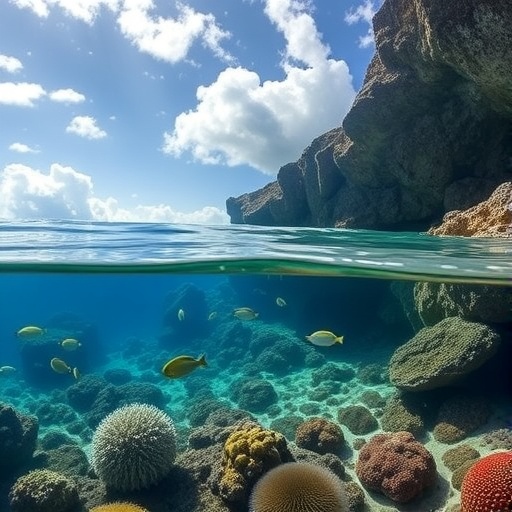A groundbreaking new study from the Institut de Ciències del Mar (ICM-CSIC) sheds light on the complex and intertwined impacts of ocean acidification and warming on marine ecosystems, focusing particularly on bryozoans—colonial invertebrates vital for the creation of underwater habitats. Published in the renowned journal Communications Biology, the research explores how these climate change-driven environmental stressors affect not only the physical structure but also the mineral composition and microbial associations of these small yet ecologically significant organisms.
Bryozoans, despite being less conspicuous than corals, play a pivotal role in marine ecosystems by forming three-dimensional structures that serve as shelter and vital habitats for a plethora of marine species. Among them, Myriapora truncata, commonly known as “false coral,” has garnered special attention as researchers embarked on the first ever characterization of its microbiome. This colony-forming species, prevalent throughout the Mediterranean Sea, features skeletons that are both mineralogically distinct and ecologically indispensable. Unlike corals which monopolize public and scientific attention, bryozoans remain a relatively overlooked phylum, even though their abundance and diversity underscore their importance in marine biodiversity.
What sets this study apart is its innovative use of a natural CO₂ vent system located near the island of Ischia, Italy. This unique environment produces volcanic bubbles rich in carbon dioxide, simulating future ocean acidification scenarios projected for the end of the 21st century. By studying bryozoan colonies situated both within and outside this high CO₂ environment, researchers could closely observe physiological and ecological responses under authentic conditions rather than in artificial laboratory setups alone. This “natural laboratory” approach provides invaluable insights into how organisms might adapt to or suffer in future ocean conditions.
The research team performed some of the most advanced analyses to date, including high-resolution 3D microtomography, to visualize and quantify changes in the internal skeletal architecture of Myriapora truncata and another encrusting bryozoan species. These scans revealed that although bryozoans demonstrate some degree of morphological plasticity—altering the mineral content of their skeletons to bolster resistance—the modifications are insufficient to fully counterbalance the detrimental impacts of combined acidification and warming. This diminished calcification capacity raises concerns about the structural integrity of bryozoan habitats and the cascading effects on marine biodiversity.
Moreover, the study ventured beyond skeletal changes to examine alterations in the bryozoans’ microbial communities, illuminating an important but previously unexplored dimension of these animals’ responses. The microbiome, a complex consortium of bacteria and other microorganisms, plays a critical role in host nutrition, immune defense, and environmental stress resilience. Findings indicate a substantial loss in functional microbial diversity when exposed to acidified and warmed conditions, suggesting that critical symbiotic relationships are disrupted. Such shifts in microbiome composition could impair bryozoan health and reduce their ability to withstand ongoing environmental stressors.
Intriguingly, colonies exposed to stressors often appeared externally healthy and maintained relatively stable microbiome compositions in terms of species presence. However, the diminished functional diversity revealed through metagenomic and functional assays points to early-warning signs of ecological distress that would be undetectable through mere visual inspection. This highlights the importance of microbial indicators as sensitive bioindicators of ecosystem health in the face of climate change.
The observed effects intensified over a longitudinal period spanning five years, during which rising sea temperatures also exerted significant additional pressure on bryozoan populations. Data modeling revealed that the synergistic combination of acidification and warming not only reduced bryozoan coverage but also increased mortality rates. While some species showed capacity for acclimation, such biological plasticity was insufficient to forestall long-term population declines. This adds a compelling layer of urgency to marine conservation efforts, emphasizing that mitigating one stressor alone may be inadequate if other climate variables continue unchecked.
Critically, these results carry broad implications for Mediterranean marine ecosystem management. Habitat-forming bryozoans maintain intricate, multifaceted relationships with other marine species, providing shelter and food sources fundamental to ecosystem functioning. The potential loss or decline of bryozoan assemblages could disrupt these relationships, triggering food web imbalances and habitat degradation. Thus, protecting bryozoans from climate-induced stressors becomes not just an act of preserving a single species, but an intervention to safeguard entire ecological communities.
This research initiative, born under the MedCalRes National Plan and continuing through the HOLOCHANGE and MedAcidWarm projects, leverages interdisciplinary expertise to unravel bryozoan–microbiome interactions under stress. Such integrated approaches encompass mineralogy, microbiology, ecology, and climate modeling, offering a comprehensive picture of organismal responses under multifactorial global change scenarios. Furthermore, exploring the microbiome’s potential to enhance holobiont resilience opens promising pathways for nature-based solutions to foster adaptation and conservation.
Beyond expanding scientific knowledge, the project also embraces innovative science communication strategies. The generation of detailed 3D skeletal models serves not only analytical purposes but also supports engaging visualization for educational outreach. Collaborations with visual storytelling studios aim to translate these complex findings into accessible animations for broader public engagement—critical for building societal awareness around climate impacts in vulnerable marine ecosystems.
Ultimately, this pioneering study paves the way for future research to address gaps in understanding bryozoan ecology and their responses to environmental stressors. It exemplifies how natural environmental “laboratories” can inform predictions of organismal and ecosystem dynamics under accelerating global change. As climate-induced ocean changes continue to challenge marine biodiversity, this work underscores the need for proactive, knowledge-driven conservation strategies that consider the multifaceted biological and ecological dimensions of critical species like bryozoans.
By charting the nuanced interplay between calcification processes, microbiome integrity, and combined environmental insults, this research offers a vital framework for anticipating and potentially mitigating climate change impacts on marine habitats. As Dr. Blanca Figuerola from ICM-CSIC states, understanding these complex interactions requires interdisciplinary collaboration. Only through such concerted efforts can science hope to safeguard the “small architects” of the sea and, by extension, the myriad lifeforms that depend on their underwater architectures for survival.
Subject of Research: Animals
Article Title: Interactive effects of ocean acidification and warming disrupt calcification and microbiome composition in bryozoans
News Publication Date: 31-Jul-2025
Web References:
DOI: 10.1038/s42003-025-08524-8
Image Credits: Credit: ‘False coral’ is widely distributed in the Mediterranean. ICM-CSIC
Keywords: Marine biology




